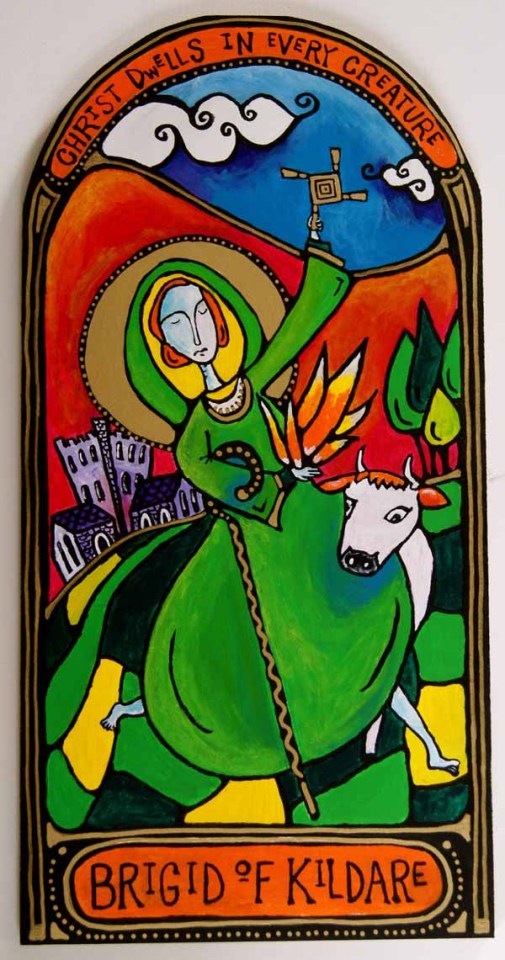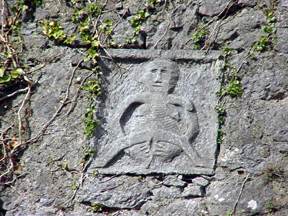Rediscovering Brigid
Like their pagan mothers and grandmothers, the women of early Christian Ireland lived comfortably with power. It wasn’t a feminist paradise—their society was ruled, after all, by aristocratic warriors—but women who became Christians were still influential in the new religion. Brigid of Kildare is one of the best examples. Today is her feast day.

Patrick himself, in his Letter to Coroticus, remarks that the number of Irishwomen “becoming virgins for Christ was beyond number.” Not only were they founding major monasteries, they were (unlike their European counterparts) traveling solo, preaching to pagans, befriending bishops, performing miracles, and receiving grants of land from kings.
Unlike their European sisters, they refused to be enclosed in cloisters. Instead, they were abbesses, wielding their crozier, the staff that still serves as a symbol of authority of a bishop. They were in charge of large “double monasteries” of both monks and nuns; they ruled over enormous federations of daughter houses; they provided employment to lay people living in the region; they educated both men and women. They provided hospitality to traveling clergy and kings and received hospitality in turn. They ministered to the poor and the sick. They heard confessions and dispensed absolution to their nuns and to the laypeople in in their communities. They wore a bishop’s mitre. There’s even evidence that some of them served at the altar, celebrated Mass, distributed communion. We know all this because although the hierarchy has tried to erase the history, some of the liturgical remnants have survived.
Their record was impressive. But most impressive of all was Brigid, abbess of the monastery at Kildare. She was an abbess on steroids, proof that there was an important place for women in the fifth-century Irish church.
Consider this: If Patrick preached the Gospel with authority he received from Rome, Brigid took her authority directly from God. In one account of her life, Brigid, bored by Patrick’s sermon, falls asleep, only to reveal on awakening that she’d received her own heavenly vision, straight from the divine, and proceeded to share it with Patrick and his followers. Patrick may have been the apostle of Ireland, but Brigid, who communed directly with God, was his spiritual superior.
At her monastery, she educated male saints including luminaries like Brendan, reputed to have been the first European to sail across the Atlantic to North America. She negotiated peace treaties between warring petty kings in her province and beyond; she administered what amounted to a diocese—a federation of monasteries and daughter houses over a vast swath of southern Ireland. She revealed the father of a baby whose paternity was under dispute; she performed a miraculous abortion on one of her nuns. She was known for her generosity, and kindness and her many miracles were reminiscent of those of Jesus: She turned a lake into beer for thirsty lepers, multiplied loaves for a feast with visiting clerics, drove a demon from a man possessed. Ordained a bishop, she passed her episcopal authority on to her successor abbesses. As the leader of her faith community, she performed liturgical functions, from hearing confessions and granting absolution to preaching the Gospel to even—some evidence suggests—celebrating the Eucharist.
Brigid wasn’t the only prominent woman in the early church, but her story is the most remarkable—and enduring—one, showing a church deeply connected to its pagan past. Baptized in milk, straddling the worlds of Christianity and the old religion, she helped form a faith community that understood, and practiced, Christianity in a thoroughly feminine way.
The practice of baptizing in milk was banned in the 1200s, putting an end—officially—to old Irish practices connected to the pre-Christian feminine religion. But those practices linger in quiet ways today.
In Irish folk Catholicism, the history and power of early Christian women is alive and well. Out in the countryside, in villages and woods barely touched by the modern world, the sacred trees and holy wells and Sheela-na-gigs—exaggerated stone carvings of women in the bearing-down position of giving birth—are still there. Young brides still rub their fingers over the Sheela-na-gigs they enter church, beseeching the pagan goddess for a healthy pregnancy and safe delivery. With fresh reeds from the edge of holy wells, schoolgirls still make Brigid’s crosses, weaving the story of the pagan goddess of the sun into the story of the Christian saint. They may not realize it, but they’re continuing to merge their faith with the pagan past, the Christian present, and the uncertain future.
For a twenty-first century church in crisis, we can turn to Brigid and her sisters for inspiration and courage. The voices of women, their ministry—and their priestly orders—were important then. They’re crucial to the church today. Their stories can help us find a path to a profoundly incarnational faith, deeply focused on nature and God’s immanent presence, in which welcoming women to Holy Orders is perceived as natural and right. They can lead us to rebuke the theology that sees women as imperfectly formed men, a theology that set the stage for centuries of oppression. Brigid can help us reclaim the roles to which our baptism has called us. In this synodal year, she can show the people of God—including the clergy—that in the long-ago past women have imaged Christ as leaders of the church. And they are ready to serve as leaders once again.
Lá Fhéile Bríde Shona Daoibh! Blessings on the Feast of St. Brigid!


2 Responses
We have to rediscover a feminist Christology whereby it is made clear that what matters for the redemption, and the sacramental economy, is the embodied human nature of Christ, not his maleness.
Wonderful, Nancy. Thank you. Even without the stories of miraculous events seemingly permeating her life, probably embellished more and more down through the ages, your portrayal of Brigid shows us a fearless, determined, diligent, and wise model to serve as inspiration for all of us working for gender equity in the Church and in the world.